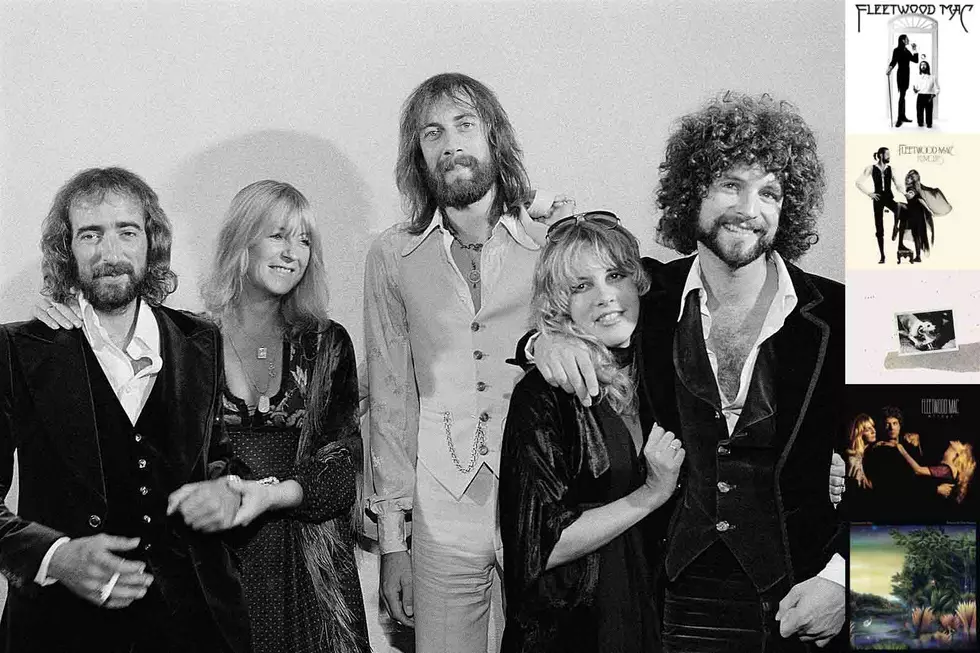
Ranking Every Classic-Era Fleetwood Mac Song
Fleetwood Mac's classic period was more than a commercial juggernaut that led to one of the biggest-selling records of all time. It was also an era marked by the veteran group's creative peak. With the additions of Americans Lindsey Buckingham and Stevie Nicks, the British band settled on a steady lineup, after a half-decade of consistent turnover, with its 10th album.
From 1975-87, the lineup of singer, songwriter and guitarist Buckingham, singer and songwriter Nicks, drummer Mick Fleetwood, singer, songwriter and keyboardist Christine McVie and bassist John McVie recorded five albums, as well as a handful of B-sides, outtakes and stray cuts that ended up on other records before and after their time together.
The below ranking of every classic-era Fleetwood Mac song includes more than 75 tracks from those key years. It doesn't contain any of the works-in-progress or early demos of released songs found on expanded versions of the band's five studio records. It also doesn't include the 1997 live reunion album The Dance or the 2003 LP Say You Will and 2013's Extended Play, neither of which included Christine McVie.
78. "Kiss and Run" (From Expanded Version of Tusk, 2004)
This pointless jam of an obscure cover from the Tusk sessions ended up on a later reissue. This is the sort of thing the band was trying to leave behind in the mid-'70s.
77. "Book of Miracles" (From "Seven Wonders" B-side, 1987)
An instrumental that laid the basis for the song "Juliet" on Nicks' 1989 solo album The Other Side of the Mirror, "Book of Miracles" never gets out of the demo stage.
76. "One More Night" (From Fleetwood Mac Live, 1980)
Three new songs were added to the concert souvenir Fleetwood Mac Live album in 1980. This was Christine McVie's. It sounds unfinished and rushed.
75. "Farmer's Daughter" (From Fleetwood Mac Live, 1980)
A 1963 Beach Boys song recorded during the Tusk sessions, "Farmer's Daughter" appeared on 1980's Live with added audience. A slight, and rare, cover by the lineup.
74. "Cool Water" (From "Gypsy" B-Side, 1982)
Only Buckingham and John McVie (on backing vocals) are on this cover of the late-'30s cowboy tune gracing "Gypsy"'s flip side. Disposable.
73. "Teen Beat" (From 25 Years: The Chain, 1992)
Another Mirage outtake, the Buckingham instrumental "Teen Beat" stayed unreleased for a decade before it showed up on The Chain box set. More sketch than a song.
72. "Goodbye Angel" (From 25 Years: The Chain, 1992)
Left off Mirage, Buckingham's "Goodbye Angel" warms up nostalgia with solo-career tricks: doo-wop via a DIY path, if you will. Finally surfaced on a 1992 Mac box set.
71. "Sugar Daddy" (From Fleetwood Mac, 1975)
Christine McVie's "Sugar Daddy" is such a throwaway song by the group that nobody put much effort into it. Never played live either.
70. "Straight Back" (From Mirage, 1982)
A Nicks song about her solo career that sounds like a leftover from her first solo album. The rest of the band does little here than provide session backup.
69. "You and I, Part II" (From Tango in the Night, 1987)
Part one is on the "Big Love" single B-side and features only Buckingham; Christine McVie joins for the album version. Stitched together as one track for a later reissue.
68. "When I See You Again" (From Tango in the Night, 1987)
The second-to-last song in Tango in the Night, this tender acoustic ballad from Nicks (with backing vocals by Buckingham) doesn't do or say much. Pretty thin.
67. "Welcome to the Room ... Sara" (From Tango in the Night, 1987)
Nicks spent time recovering from addiction at the Betty Ford Clinic before making Tango in the Night. This song - complete with a callback to her earlier "Sara" - details her stay.
66. "Mystified" (From Tango in the Night, 1987)
Written by Lindsey Buckingham and Christine McVie and mostly sung by her, "Mystified" is barely a whisper of a song. Snoozy and forgettable.
65. "Honey Hi" (From Tusk, 1979)
Tusk's Side Four opener is as disposable as the underrated album gets. Not even Buckingham's lavish production can salvage Christine McVie's blueprint of a song.
READ MORE: Top 10 Pre-Lindsey Buckingham-Stevie Nicks Fleetwood Mac Songs
64. "Down Endless Street" (From "Family Man" B-Side, 1987)
Most Tango in the Night singles contained non-album tracks as flips; none deserved a spot on the album. Buckingham's "Down Endless Street" is better than most, though.
63. "Wish You Were Here" (From Mirage, 1982)
Mirage's closing song - co-written by Christine McVie and British drummer Colin Allen - ends the album on a reflective, longing note. Pleasant if not necessarily memorable.
62. "Eyes of the World" (From Mirage, 1982)
Buckingham borrowed from "Pachelbel's Canon" for Mirage's penultimate track, which - like most of his songs on the LP - sounds more suited to his solo career.
61. "Empire State" (From Mirage, 1982)
California native Buckingham's tribute to New York (co-written with Richard Dashut) opens Mirage's second side. As with other songs from the LP, he doesn't sound into it.
60. "That's Alright" (From Mirage, 1982)
Stevie Nicks wrote "That's Alright" before she and Lindsey Buckingham joined Fleetwood Mac in 1974. Under the deadline for songs, she excavated the lilting, county-gallop number for Mirage.
59. "Can't Go Back" (From Mirage, 1982)
During the three-year recording hiatus between Tusk and Mirage, several members of Fleetwood Mac pursued solo careers that resulted in a surplus of leftover songs used on the band's 13th LP. "Can't Go Back" is Buckingham in full quirky pop mode.
58. "Caroline" (From Tango in the Night, 1987)
Buckingham layers percussion and studio tricks into this sparkling but unmemorable offering to Tango in the Night. The '80s gloss running through much of the album is at a minimum here, but "Caroline" is not much of a song either.
57. "Never Forget" (From Tusk, 1979)
Christine McVie had both the opening and closing songs on Tusk. "Never Forget," which ends the double LP, drifts in like a final benediction after the weirdness and solo turns. It works better as a bookend than as a stand-alone song, though.
56. "Save Me a Place" (From Tusk, 1979)
One of Buickingham's lesser songs on Tusk sounds like a ramp-up to his solo career, which was right around the corner. Running a little more than two and a half minutes, "Save Me a Place" never takes off.
55. "Angel" (From Tusk, 1979)
The second Fleetwood Mac song with the title "Angel" (the first, by Bob Welch, is from 1974's Heroes Are Hard to Find), Nicks' version alludes to her relationship with Mick Fleetwood. It leads Side Three of Tusk but lumbers throughout its nearly five minutes.
54. "Ricky" (From "Little Lies" B-Side, 1987)
Co-written by Buckingham and Christine McVie, the "Little Lies" B-side was left over from the Tango in the Night recording sessions. No surprise why the song was left off the album; there's not much here.
53. "Oh Daddy" (From Rumours, 1977)
The worst song on the massively popular Rumours was written by Christine McVie about either her boyfriend or Mick Fleetwood's marital problems. Either way, it's appropriately buried in the graveyard position as the album's penultimate track.
52. "Only Over You" (From Mirage, 1982)
Christine McVie's "Only Over You" is most notable for being about her relationship with Beach Boys drummer Dennis Wilson that ended the same year Mirage came out. He died in 1983, drowning while intoxicated.
51. "Beautiful Child" (From Tusk, 1979)
Stevie Nicks had a brief affair with former Beatles press agent Derek Taylor before the recording of Tusk. The lullaby-like "Beautiful Child" is about him. At almost five and a half minutes, the song may last longer than the relationship did.
50. "Book of Love" (From Mirage, 1982)
Like several Mirage tracks, Buckingham's "Book of Love" sounds like it would be just as well-suited to a solo record. Glistening pop melody, chiming backing vocals, layered instruments and voices: check, check and check.
49. "Walk a Thin Line" (From Tusk, 1979)
Comparisons to the Beatles' White Album greeted Tusk from the start. This Buckingham song later made a clearer connection when George Harrison played guitar on a version found on Mick Fleetwood's debut solo album, The Visitor, in 1981.
48. "I Know I'm Not Wrong" (From Tusk, 1979)
Like his other songs on Tusk, Buckingham's "I Know I'm Not Wrong" was heavily influenced by the punk and new wave music infiltrating the culture at the time. It wasn't an easy birth: He reportedly reworked the track several times during recording.
47. "Never Make Me Cry" (From Tusk, 1979)
Another sensitive, hushed Christine McVie song, buried in the back half of Tusk and free from the meticulous studio techniques that define so much of the album. Restrained to the point of forgettable, the performances are nonetheless lovely.
46. "Isn't It Midnight" (From Tango in the Night, 1987)
Everything about this mid-'80s song by Christine McVie (who sings lead), Buckingham and Eddy Quintela is period-stamped, from its hollow production to the brief, shuttled-in guitar solo. It was the last single released from Tango in the Night but bombed.
45. "Tango in the Night" (From Tango in the Night, 1987)
Originally intended for Buckingham's third solo album, "Tango in the Night" was instead reworked by Fleetwood Mac as the title track of their 14th LP. No Stevie Nicks, but the rest of the band checks in with the album's toughest performance.
44. "Brown Eyes" (From Tusk, 1979)
This Christine McVie-written and -sung song is most notable for featuring an uncredited guitar performance at the fade-out by Peter Green, the band's founder who left in 1970. He doesn't remember it; Buckingham doesn't either. The song is mostly forgettable, too.
43. "That's Enough for Me" (From Tusk, 1979)
Tusk's shortest song was written and sung by Buckingham, who also plays all the instruments (Nicks and Christine McVie supply backing vocals, though). "That's Enough for Me" went through several stages before the lively 1:51 version was settled on.
42. "Crystal" (From Fleetwood Mac, 1975)
"Crystal" first appeared on Buckingham and Nicks' 1973 album and showed up again on the duo's first Fleetwood Mac album. Like the earlier version, Buckingham sings lead on the Nicks-penned song. She finally took the lead on a 1998 soundtrack solo recording.
READ MORE: The Best Song From Every Fleetwood Mac Album
41. "Warm Ways" (From Fleetwood Mac, 1975)
Curiously, this Christine McVie-written and -sung track from Fleetwood Mac's breakthrough album has never been performed live. Its dream-like guitar and hazy vocals recall an earlier time of the band. A pleasant bridge between eras.
40. "The Ledge" (From Tusk, 1979)
Lindsey Buckingham's first song on the album on which he served as the main architect is the sort of method-to-his-madness track he'd construct from here on out. Rhythmically hyperactive, lyrically oblique and overdubbed to the point of bursting, "The Ledge" is a wonderfully weird intro to Tusk's awaiting treasures.
39. "That's All for Everyone" (From Tusk, 1979)
Lindsey Buckingham didn't hide his admiration for the Beach Boys and, especially, Brian Wilson. (Fleetwood Mac's take on the Beach Boys' "Farmer's Daughter" is one of their few covers during the Buckingham-Nicks era.) Tusk is filled with pristine studio nods, none more elegant than this dream-like ballad from the LP's second side.
38. "Oh Diane" (From Mirage, 1982)
Buckingham wrote a handful of his Mirage songs with the album's co-producer Richard Dashut, including this 1950s throwback. Stevie Nicks is nowhere to be found on the gauzy but melodic "Oh Diane," but the rest of the band checks in with reserved yet steady backing, including Christine McVie with faraway vocals.
37. "Blue Letter" (From Fleetwood Mac, 1975)
A rare cover during the Buckingham-Nicks era of the band arrived on the first album from the new lineup, but "Blue Letter" sounds like such a part of the rest of the LP that it's hard to imagine the record without it. The Curtis Brothers, friends of the pre-Mac Buckingham and Nicks, wrote the song, a breezy pop gem.
36. "Over & Over" (From Tusk, 1979)
The opening track on Tusk doesn't hint at the weirdness that follows. In some ways, it's an appropriate start to the lineup's least cohesive and most uncompromising record, a graceful Christine McVie ballad that no other band would risk putting in the opening slot. The LP's next song unveils its true intentions.
35. "I Don't Want to Know" (From Rumours, 1977)
"I Don't Want to Know"'s tangled history was a source of friction during the Rumours sessions. Nicks wrote the song in her pre-Fleetwood Mac days; it ended up on the album only because the better "Silver Springs" was pulled for time. Then Buckingham sang lead. Threatened with fewer songs on the LP, she begrudgingly added backup.
34. "Not That Funny" (From Tusk, 1979)
Punk and new wave were starting to find their way into the U.S. mainstream between Rumours and Tusk; "Not That Funny" was Buckingham's response. From the near minimalist backing to his vocals and guitars, both on the verge of collapse by the song's end, it features a virtuoso performance by the album's mastermind.
33. "What Makes You Think You're the One" (From Tusk, 1979)
So many of Lindsey Buckingham's songs on Tusk appear to be somewhere between the early sketchbook and endless-tweaking stages. "What Makes You Think You're the One" is the best of them. From Mick Fleetwood's trashcan drums to the quiver in Buckingham's voice, it's the album aesthetic at its most gloriously shambolic.
32. "You & I (Part 1)" (From "Big Love" B-Side, 1987)
"You & I (Part 2)" can be found on Tango in the Night, with Christine McVie sharing vocals with Buckingham. He's on his own on "Part 1" flipping the switch on the song as a multitextured solo number, fittingly found on the B-side of the "Big Love" single, his most complex pop turn with the group since "Tusk" eight years earlier.
31. "Storms" (From Tusk, 1979)
While Lindsey Buckingham gets much credit for Tusk's shape and sound, Nicks contributed five personal songs to the project, including this five-and-a-half-minute moody ballad about her doomed relationship with Mick Fleetwood. A quiet gem that slowly reveals its power.
30. "I'm So Afraid" (From Fleetwood Mac, 1975)
The closing track on the album that finally broke Fleetwood Mac in the States had been workshopped by Buckingham since the start of the '70s. Unlike most soft-rock songs on the LP, "I'm So Afraid" finds the band approaching their instruments with an intensity not heard since Peter Green left. A fitting close to a new-era record.
29. "World Turning" (From Fleetwood Mac, 1975)
Fleetwood Mac's 1968 song "The World Keeps on Turning" gets reworked by the current lineup seven years later. The only co-write between Buckingham and Christine McVie on the 1975 LP, the track is distinguished by its guitar and percussion interplay - the closest the new lineup got to the original group's blues roots.
28. "Songbird" (From Rumours, 1977)
Written by Christine McVie and featuring only her on vocals and piano and Buckingham on acoustic guitar, "Songbird" is one of the most personal songs in her repertoire. For years the Rumours Side One closer ended Fleetwood Mac shows. John McVie once said he wept every night onstage when his former wife played it.
27. "Never Going Back Again" (From Rumours, 1977)
A solo showcase for Buckingham, who addresses - as he does on much of Rumours - his breakup with Nicks. More so than subject, his guitar skills are on full display here, as he fingerpicks his way through "Never Going Back Again," a highlight of both band and solo tours.
26. "Monday Morning" (From Fleetwood Mac, 1975)
The first song greeting listeners to Fleetwood Mac's new lineup on their 1975 self-titled album wastes no time introducing their new hotshot singer, songwriter and guitarist. In less than three shimmering minutes, Lindsey Buckingham definitively states a purpose. With their 10th LP, the band finally had a No. 1 hit and its history turned.
25. "Second Hand News" (From Rumours, 1977)
Like on the debut album from the new and revitalized Fleetwood Mac, Buckingham gets the first song on the follow-up. And what a lead-in: "Second Hand News" was the singer and guitarist's attempt to replicate the Bee Gees' strutting "Jive Talkin'" beat. It sets the stage for Rumours' breakup tales, ushering in one of the '70s' greatest albums.
24. "Family Man" (From Tango in the Night, 1987)
Like several of Buckingham's Tango in the Night songs, the springy "Family Man" was first slated for his third solo album but shuttled over to Fleetwood Mac when they started work on their 14th LP. Most everything on the song is played by Buckingham, except for some percussion by Fleetwood and flown-in vocals from Nicks. A low-charting single.
23. "Fireflies" (From Fleetwood Mac Live, 1980)
One of three new songs included in 1980's Fleetwood Mac Live, Nicks' "Fireflies" wasn't a concert recording but taken from an intimate performance for the crew staged during the tour. With references to "my five fireflies," the song is about the state of the band relationships at the start of the '80s. Released as a single, it peaked at No. 60.
22. "Sisters of the Moon" (From Tusk, 1979)
Tusk's fourth single would get a workout onstage, often approaching 10 minutes. Stevie Nicks wrote the song a couple of years before its appearance on the 1979 double album, even performing it live during the Rumours tour. Another personal song, "Sisters of the Moon" was partly about Nicks' mental and physical health battles on the road.
21. "Love in Store" (From Mirage, 1982)
Like on Tusk, Christine McVie received the opening song on Mirage, but this time the promise of a more conventional record was followed through. After the previous record's relative failure in comparison to Rumours' huge sales, the group scaled back ambitions on its 13th album. "Love in Store" was melodic and to the point. A Top 25 U.S. single.
20. "Think About Me" (From Tusk, 1979)
Despite its reputation as a commercial failure, Tusk still managed to place three songs in the U.S. Top 20, including this single written and primarily sung by Christine McVie. One of the more straightforward rock songs on the art-leaning album, "Think About Me" doesn't waste a second of its 2:44 running time. And check out Buckingham's ease at settling into his role as guitarist and backing vocalist. An underrated highlight.
19. "Over My Head" (From Fleetwood Mac, 1975)
Warner Bros. still wasn't sure if Fleetwood Mac's latest additions - Americans Buckingham and Nicks joined the British group on New Year's Eve of 1974 - would amount to much, so they hedged their bets with the 10th album's lead single, choosing a song by band veteran Christine McVie. "Over My Head" was their first Top 40 hit in the U.S., making it to No. 20. The new era started here.
18. "Seven Wonders" (From Tango in the Night, 1987)
Written by Sandy Stewart, who worked with Nicks on her 1983 solo album The Wild Heart, "Seven Wonders" was the second, and safer, single from Tango in the Night, following Buckingham's typically bizarre "Big Love." By this point Nicks was settled into her solo career and fighting back her addictions; "Seven Wonders" - co-credited to Nicks, who misheard a lyric and sang a new one - is one of her great singles.
17. "Little Lies" (From Tango in the Night, 1987)
By the classic era's last album together, the songwriting was pretty much democratic with all three of the principals contributing backing vocals to each of their songs. Written by Christine McVie and husband Eddy Quintela, "Little Lies" was the third single pulled from Tango in the Night; Buckingham and Nicks chime in, stepping up for solo turns during the cascading chorus.
16. "Gold Dust Woman" (From Rumours, 1977)
The closing song on the era-defining Rumours went to Nicks, whose struggle for identity within the band helped stage so much of the drama behind it. Like most of the songs on the album, "Gold Dust Woman" was based on personal experience - in this case, Nicks' growing addiction to cocaine. The imagery isn't subtle, but her delivery of the song's key lines - "Is it over now? ... Pick up the pieces and go home" - feel lived in and worn out.
15. "Hold Me" (From Mirage, 1982)
Three years after the expensive double album Tusk nearly tore apart the band, Fleetwood Mac scaled back and staged a comeback with the less ambitious Mirage. "Hold Me," co-written by Christine McVie with Robbie Patton and featuring a shared lead vocal by her and Buckingham, was pretty straightforward and served its purpose: The song became the band's first Top 5 hit since the Rumours days.
READ MORE: How Fleetwood Mac Made a Masterpiece Out of Messy Relationships on 'Rumours'
14. "Say You Love Me" (From Fleetwood Mac, 1975)
Like "Rhiannon," Christine McVie's "Say You Love Me" just missed becoming Fleetwood Mac's first U.S. Top 10, stopping at No. 11. But it helped carry the group's self-titled 1975 album to No. 1, paving the way for the gargantuan success that would follow with Rumours two years later. Engaging and casual, and features a frontline mix of three voices finding their groove.
13. "You Make Loving Fun" (From Rumours, 1977)
The personal lives of Fleetwood Mac leading up to the making of Rumours famously went into the finished record. While Buckingham and Nicks took swipes at each other, Christine McVie celebrated moving on from her divorce with this love song about a new relationship (with the band's lighting director, no less). It couldn't have been easy for her ex John to play the song each night.
12. "Big Love" (From Tango in the Night, 1987)
"Big Love" opened Fleetwood Mac's first album in five years and was also released as the premiere single from Tango in the Night. The song was a hit on the dance charts, its 12-inch version featuring new vocals by Nicks (who didn't appear on the LP and single takes). Like other songs on the album, "Big Love" was originally intended for a Buckingham solo record before the band claimed it. A highlight from the group's '80s.
11. "Gypsy" (From Mirage, 1982)
Mirage showed signs of a band reluctantly coming together for another try following the commercial stalling of its predecessor Tusk. Solo careers were on the minds of the band's three singer-songwriters, and their respective songs expose this. "Gypsy," however, is one of the album's rare tracks that sounds like a group project, including a great Nicks performance and composition, and a dazzling guitar by Buckingham.
10. "Sara" (From Tusk, 1979)
Tusk is often viewed as Buckingham's pet project, but he was as generous with his bandmates' songs as he was his own. Nicks' "Sara" - the album's highest-charting single - is her showpiece, a slow-building tale of longing with just enough of the author's mysticism to catch up to the lavish production and the band's restrained performance. Avoid the single version, which trims nearly two minutes of atmosphere.
9. "Everywhere" (From Tango in the Night, 1987)
Tango in the Night was a final attempt by Fleetwood Mac to hold things together amid clashing egos, time-consuming solo careers and disinterest by at least a few of the members. It says much about the period that the album's best song, "Everywhere," was released as the fourth single more than half a year after the LP's release and Nicks is nowhere to be found. Written and sung by Christine McVie at her most elegant.
8. "Silver Springs" (From "Go Your Own Way" B-Side, 1976)
The song that almost broke Stevie Nicks is one of her greatest. Omitted from Rumours, "Silver Springs" - a detailed look at her and Buckingham's splintered personal relationship - left Nicks hurt and upset that the song was relegated to the B-side of the album's first single, "Go Your Own Way." Nicks was vindicated years later when the song was added to the LP's track listing and became a highlight of The Dance reunion.
7. "Don't Stop" (From Rumours, 1977)
By the time "Don't Stop" was released as Rumours' third single in the spring of 1977, the album was already on its way to becoming one of the biggest in music history. Even though Christine McVie wrote the song (about her split from bassist husband John), Buckingham sings lead on most of it. But she joins him in the chorus and takes the second verse by herself. An enduring Top 10 hit.
6. "Tusk" (From Tusk, 1979)
After a two-year wait (a long break by mid-'70s terms), one of the biggest bands in the world returned with their follow-up to one of the bestselling albums ever. This was the first song released, and it gave a glimpse of the odd, commercially averse music to come. Driven by peculiar percussion and climaxed with a USC Marching Band horn explosion, "Tusk" sounded unlike anything on the radio in 1979. Or ever.
5. "Landslide" (From Fleetwood Mac, 1975)
Stevie Nicks was only 26 when she wrote one of her most enduring songs, a reflection on life and time and growing old that remains a milestone record in her songwriting career. "Landslide"'s popularity as a cover song for other artists is a testament to its timeless appeal, but it's Nicks' sensitive performance on her first album with Fleetwood Mac that remains the essential recording. Beautiful, haunting and ageless.
4. "Rhiannon" (From Fleetwood Mac, 1975)
The song that helped define Stevie Nicks' image and set a new era of Fleetwood Mac on the way, "Rhiannon" has taken on a more epic status in concert, but the version from the 1975 LP is pretty perfect, too. The track reportedly took some time to get right in the studio. The effort was worth it: Nicks' song about a Welsh witch is one of her best and helped set the new-era Fleetwood Mac on course.
3. "The Chain" (From Rumours, 1977)
The only song on the mammoth Rumours album to get a full band co-write, "The Chain" kicks off Side Two and reinforces the bonds among the members, despite personal relationships falling apart around them. Assembled from leftover pieces of other songs, "The Chain" has become one of the most durable tracks from the group's most celebrated lineup. Whatever their differences, they are one strong force here.
2. "Dreams" (From Rumours, 1977)
There was no disguising the hurt and anger running throughout most of Rumours' songs, as Buckingham and Nicks, as well as the McVies and drummer Mick Fleetwood, adjusted to changes in their relationships. But Buckingham and Nicks took it to another level; her classic "Dreams" doubled as a consolation following her breakup with Buckingham and quickly became the band's only No. 1 single in the U.S.
1. "Go Your Own Way" (From Rumours, 1977)
Even though Lindsey Buckingham got the opening song on his first album with Fleetwood Mac, none of his two solo compositions were released as singles. That changed with follow-up Rumours, which was previewed two months before its release with "Go Your Own Way," his barbed take on his relationship split with Stevie Nicks. He and the band were rewarded with their first U.S. Top 10 and the start of a monumental period in the group's storied history.
Fleetwood Mac Albums Ranked
Gallery Credit: Nick DeRiso






